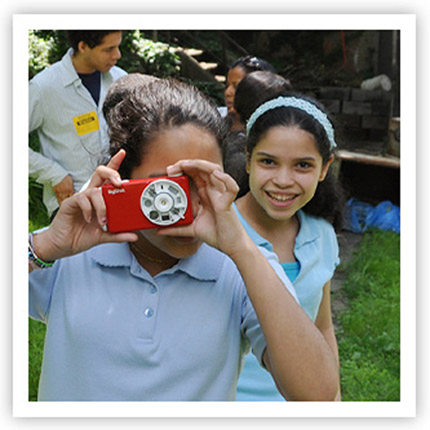
Children test a Bigshot prototype in New York.
Shree Nayar, chair of the Computer Science Department at Columbia University, spends his workdays marrying computers with cameras, inventing novel ways to acquire, enhance and interpret the images that result when light strikes a lens. His projects tend to be of the variety that cannot be discussed without words such as “algorithm” cropping up within minutes. But he is equally devoted to ideas a child can understand — like Bigshot, a versatile camera he invented for children ages 8 to 14.
Packaged as a kit of parts, Bigshot teaches scientific and engineering principles along the way to assembly. Not only do kids have the fun of building a useful object from scratch, but as they manipulate the lenses, gears and dynamo (the camera is powered with a hand crank), they learn about optics, mechanics and energy. A companion website designed by Nayar and several of his Columbia graduate students offers lucid tutorials in each concept.

Bigshot's front face contains a wheel with multiple lenses, its back is transparent to show how the components perform when the camera's in useShree Nayar, chair of the Computer Science Department at Columbia University, spends his workdays marrying computers with cameras, inventing novel ways to acquire, enhance and interpret the images that result when light strikes a lens. His projects tend to be of the variety that cannot be discussed without words such as “algorithm” cropping up within minutes. But he is equally devoted to ideas a child can understand — like Bigshot, a versatile camera he invented for children ages 8 to 14.
Packaged as a kit of parts, Bigshot teaches scientific and engineering principles along the way to assembly. Not only do kids have the fun of building a useful object from scratch, but as they manipulate the lenses, gears and dynamo (the camera is powered with a hand crank), they learn about optics, mechanics and energy. A companion website designed by Nayar and several of his Columbia graduate students offers lucid tutorials in each concept.

Once Bigshot is put together, it functions like any other digital camera — even better than many, in that it features multiple lenses situated on a wheel. The wheel rotates to produce not only a standard perspective but also panoramic views via a wide-angle lens, and 3D images via a stereo lens. The website teaches photographic techniques, from traditional rules of composition (dividing the image field into thirds) to stitching together multiple pictures into David Hockneyesque collages. Energy produced by turning the hand crank powers the camera when its battery runs out of charge, and Bigshot’s single-LED flash can be used to teach semiconductor technology.
Giving children in the developing world the chance to practice photography and learn about its allied sciences was crucial to Nayar’s original vision for Bigshot. “I wanted to create something with social impact,” he said, speaking in his immaculate office in the grimly pragmatic building that shelters Columbia’s computer scientists. “I was convinced the camera was a good platform to think with.” Soon after being struck by this insight, Nayar saw the Academy Award–winning Born into Brothels, a 2004 documentary film about children living in Calcutta’s red light district who were handed cameras and joyfully taught to reveal the life before their eyes. “The film reaffirmed that the camera is like no other piece of technology,” he said. It raises emotions “both for the person being shot and for the person shooting.” To harness that power of expression, Nayar conceived part of Bigshot’s website as a place for children around the world to upload and share images.

Children assemble Bigshot from a kit of parts with the help of a website.
Bigshot allowed Nayar to indulge an untapped enthusiasm for design. Having been raised traditionally in India, he said, his interests were channeled into the study of engineering. Now he had to consider the arrangement of Bigshot’s components in their tray to produce the most efficient sequence for assembly. And he had to create a camera body suited to children (he flirted with a host of morphologies before concluding that the standard rectangular shape was anything but arbitrary). And then there was color: Bigshot’s first prototype was cherry red, a hue that appeals to kids and is echoed in the website’s design, but production models will be available in a palette inspired by that childhood ambrosia known as M&M’s.
Still to be worked out is the method by which the camera will be distributed to needy kids. At present, the cost of goods and assembly is $40–$50. Nayar, who is receiving some support from Google, is working with outside contactors to reduce expenses and contemplating bringing down the level of the components. “The most expensive part is the imaging chip; it may be more sophisticated than needed,” he noted. Nor does the camera really require such a high-powered microcontroller, he said. “But we had to go with things the contractors were comfortable with and had used before.” He envisions marketing Bigshot for $100 and for every 10 cameras sold, donating one to an underprivileged family or school.
Nayar has field-tested prototypes in New York, Bangalore and Vung Tau City, Vietnam, leading day-long workshops in which children build cameras in the morning, learn about photography techniques in the afternoon and present their images in the evening. (He is currently testing Bigshot in Japan and is planning forays into the Middle East and Africa.) Soon, he hopes, more of these exchanges will occur virtually, by way of his website. “Bringing down walls, visually transporting yourself to see how your eight-year-old peer in Israel, the West Bank or Africa lives,” he said. “That has great value.”


Comments [6]
Isn't that something that Paula Scher constantly says? Or is it a Pentagram thing? I feel like I am always hearing Pentagram people saying that. She said it for the Philharmonic, Bard and the MoMA.
Hmmmm....
12.23.09
10:19
DIY assembly of electronics equipment has a long history, going back at least to the 1950's and 1960's popularity of brands like Dynaco and Heathkit, which sold stereo equipment (amplifiers and such) in kit form at a discounted price from the fully factory-wired versions. That the BigShot is reviving this tradition is something to be celebrated, given the educational value of assembling a working device from its component elements.
See also: http://en.wikipedia.org/wiki/Kit-of-parts
12.23.09
11:47
01.08.10
09:01
If yes, what is its price, and the cost of shipping? Also, can it be shipped to an address in Canada, please?
Regards, Vahdat Ahmadpour
06.30.10
11:57
- Doug P.
10.11.10
09:44
12.23.13
05:05